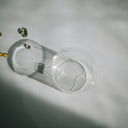Radiotherapy can be life-saving, but it often comes with some unwelcome side effects, including hair loss.
Understanding why this happens and how to manage it can help you feel more in control during treatment.
Let's break down everything you need to know and how to handle it effectively.
Table of content
Does radiotherapy cause hair loss?
Radiotherapy can cause hair loss, but only in the area being treated. Hair typically begins to fall out 2-3 weeks after starting treatment. Unlike chemotherapy, which can cause widespread hair loss, radiotherapy targets specific areas of the body. Your care team can guide you on where exactly your hair may thin or fall out.
This hair loss is usually temporary, but it can be unsettling. While the hair will likely start falling out a few weeks into treatment, it’s important to remember that not all treatments lead to the same level of loss.
Your healthcare provider can offer personalized insight based on the type and location of your treatment.
As your leading source for hair health information over the past 4 years, we never compromise on accuracy. When it comes to your health, you deserve information you can truly rely on - and earning your trust is our top priority.
Here's how Scandinavian Biolabs ensures every piece of content meets the highest standards of accuracy and integrity:
- Credentialed Experts: Our reviewers are actively practicing doctors and medical researchers
- Stringent Reviews: Content undergoes rigorous editing by subject specialists and review by a practicing doctor.
- Evidence-Based: We rely on well-established research from trusted scientific sources like peer-reviewed journals and health authorities.
- Full Transparency: Our editorial standards, writer credentials, reviewer credentials, correction process, and funding are all publicly documented.
- Independent Voice: While we do promote products, we operate in a vacuum to business operations. Our main goal is just an unwavering commitment to providing medically-sound guidance.
You can count on Scandinavian Biolabs to consistently deliver the trustworthy health information you deserve. Read our Editorial Standards.
Why does radiotherapy cause hair loss?

Radiotherapy uses high-energy radiation to target and destroy cancer cells, but this same radiation can also affect nearby healthy cells, including those in your hair follicles. When the follicles are damaged, they can’t produce hair, leading to hair loss in the treated area.
The extent of hair loss depends on the dose of radiation and the area being treated. If the treatment is focused on the head, you’re more likely to experience hair loss in that area. However, once treatment ends, the healthy cells usually recover, and hair growth can resume.
Will hair grow back after radiotherapy?
In most cases, yes, hair will grow back after radiotherapy. Typically, it starts to regrow within 3 to 6 months after treatment ends. However, if the radiation dose was particularly high, your hair may grow back thinner or, in some cases, not at all in the treated area.
Regrowth varies from person to person, and it may take a little longer for some. If the texture or thickness of your hair changes, this is usually temporary. Still, it’s a good idea to talk to your doctor if you have concerns about how your hair is growing back.
How to manage hair loss during radiotherapy
Losing hair during radiotherapy can be tough, but there are ways to manage it. Taking steps before and during treatment can help minimize discomfort and maintain your confidence.
Prior to hair loss
Preparing your hair and scalp before hair loss begins can help both physically and emotionally. Taking gentle steps early can ease the transition when hair starts to shed.
- Use a soft-bristle brush and mild shampoo: Be kind to your hair. A soft brush prevents tugging, and a sulfate-free shampoo keeps your scalp healthy without stripping oils.
- Avoid heat styling tools: Put away the hair dryer, straightener, and curling iron. Heat can make hair more fragile. Air dry or use the cool setting if needed.
- Stay away from chemical treatments: Skip hair dye, bleach, and perms. Chemicals weaken the hair shaft, making it more prone to breakage.
- Keep your scalp moisturized: Radiation can dry out your scalp, so apply a gentle, fragrance-free moisturizer or oil to keep it hydrated.
- Consider a shorter haircut: A shorter cut can make the process feel less drastic and help ease the emotional impact of hair loss.
When hair loss starts
Once hair loss begins, managing the physical and emotional changes can help you feel more in control.
- Cut your hair shorter: If you haven’t already, a shorter cut can make hair loss less shocking and give your scalp space to breathe.
- Shave your head: Some choose to shave their heads as soon as hair loss starts, finding it empowering. If you go this route, use a gentle razor to avoid irritating your scalp.
- Protect your scalp: Wear hats or scarves to protect your scalp from the sun and cold. Use sunscreen when outdoors and sleep on a satin pillowcase to reduce irritation.
- Wear a wig, scarf, or go natural: Wigs and scarves can offer confidence, but many also choose to embrace the look of hair loss. Both are valid options—do what feels right for you.
- Scalp massage: Gently massaging your scalp can improve circulation. Just be soft, as your scalp may be sensitive during this time.
Ways to care for your hair when it grows back
As your hair begins to grow back after radiotherapy, taking the right steps can support healthy regrowth and prevent further damage. Being gentle and using targeted treatments can make a big difference in how your hair recovers.
Bio-Pilixin Serum

Bio-Pilixin® Serum is designed specifically to help reduce hair thinning and encourage new hair growth. Developed with plant growth factors using stem cell technology, this serum nurtures hair follicles by stimulating blood flow and delivering essential nutrients to your scalp.
It’s a drug-free, daily-use product that has shown promising results in clinical trials.
Not only is Bio-Pilixin easy and safe to use, but 77% of participants in clinical trials reported reduced hair loss after just 45 days of consistent use.
By 150 days, over 73% experienced a measurable increase in hair density. Many users start to notice less hair shedding in the shower within just a few weeks.
The product’s effectiveness spans a wide range of hair loss types, provided the follicles are still capable of growing hair.
Starting Bio-Pilixin early can significantly improve your chances of seeing positive results, making it a helpful ally for anyone recovering from radiotherapy.
Minoxidil
Minoxidil is a well-known treatment for hair regrowth, commonly used in both men and women. Available as a topical solution, it works by widening blood vessels and improving blood flow to the hair follicles, which can stimulate regrowth in thinning areas.
Most users start seeing regrowth after around three to six months of consistent application. Minoxidil is available over-the-counter, making it accessible for those experiencing hair loss from radiotherapy or other conditions.
Finasteride
Finasteride is an oral medication that works by blocking the hormone responsible for shrinking hair follicles—DHT. While primarily used by men, it has shown success in treating male-pattern baldness and can be considered by men recovering from radiotherapy-induced hair thinning.
It typically takes three to four months for noticeable improvements, with results becoming more pronounced over time. It’s essential to consult a doctor before starting this treatment, as it does come with potential side effects.
Platelet-rich plasma (PRP) therapy
PRP therapy involves drawing a small amount of your blood, processing it to concentrate the platelets, and injecting it into the scalp. These platelets contain growth factors that can stimulate the hair follicles and promote regrowth. PRP therapy is gaining popularity as a natural, drug-free option for restoring hair, especially for those recovering from radiotherapy.
Sessions are usually spaced a few weeks apart, and many patients start seeing improvements after the third or fourth treatment. PRP can help rejuvenate damaged follicles and improve the thickness of the new hair that grows.
Other side effects of radiotherapy
Radiotherapy can affect more than just your hair. It may also lead to other side effects such as skin irritation, tiredness, and issues with eating or digestion. Here’s a quick overview of what you might expect and how to manage it.
- Sore skin: Radiotherapy can cause redness, dryness, and peeling in the treated area. It's important to keep the skin clean, pat it dry, and moisturize regularly. Avoid harsh products, and use gentle soap and soft towels.
- Fatigue: Many people experience fatigue during and after radiotherapy. Rest is key, but light exercise like walking can help boost energy levels. Don’t hesitate to ask for help with daily tasks.
- Problems eating and drinking: If the treatment area includes your mouth, throat, or stomach, you might notice soreness or loss of appetite. Soft, easy-to-swallow foods can help, as well as staying hydrated.
How long do side effects last?
Most radiotherapy side effects begin to fade within a few weeks to a couple of months after treatment ends. However, the exact timing depends on the treatment dose and area. Common side effects like fatigue and skin irritation tend to improve relatively quickly once therapy is complete, but some may linger.
In some cases, certain side effects, such as hair thinning or changes in skin color, may persist longer or even be permanent. If side effects are making daily activities difficult, your doctor may adjust your treatment schedule to help manage them better.
Conclusion
Dealing with hair loss and other side effects from radiotherapy can be challenging, but taking proactive steps can make the process more manageable.
Whether it’s choosing the right hair regrowth treatment, caring for your skin, or finding ways to combat fatigue, there are solutions to help you feel more comfortable during your recovery.
For anyone looking to kick-start their hair regrowth, Bio-Pilixin Serum offers a science-backed solution. With its 150-day money-back guarantee, it's a risk-free way to support your hair’s journey back to health.
References:





